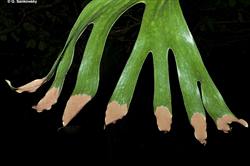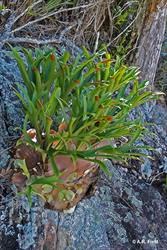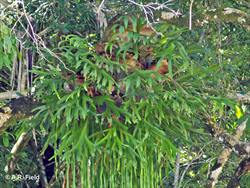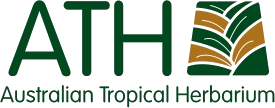Polypodiaceae
Australian Tropical Ferns and Lycophytes - Online edition
Platycerium hillii




Platycerium hillii T.Moore
Link to Australian Plant Name Index for publication details and synonyms: https://id.biodiversity.org.au/name/apni/79649
Rhizome short creeping, clothed with chaffy lanceolate scales, embeded in a nest of fronds and roots. Roots proliferous. Fronds dimorphic with sterile base fronds laminating against the host and sterile or fertilze foliage fronds emergent. Base fronds rounded-reniform, 15.5–36 cm long, at least 15–26 cm wide; upper margin entire to slightly wavy, firmly appressed to substrate, soon becoming brown. Foliage fronds ascending, 23–90 cm or more long, to 60 cm wide; base cuneate, spreading out to a broad apex; distal one-third forked 1–5 times; ultimate segments oblong, 1–6 cm wide, dark green, glabrous or almost so. Sporangia covering most of the undersurface of ultimate segments of foliage fronds, frequently reaching apex and sometimes extending around sinus of the ultimate fork. Spores 40–52.5 µm long, 20–35 µm wide.
Occurs in NE QLD from Iron Range to Cape Hillsborough.
Epiphytic or lithophytic in lowland vine forest. Most commonly seen as a large mass forming epiphyte in beach scrubs and along creeks in wet areas.
The nest fronds of this species are thick and corky and contribute to a thick sponge-like nest. The upper margin of the nest-fronds are not lobed and seal the upper surface of the nest.
Readily cultivated on a tree, rock, slab or in a pot of coarse material. Grows well in a garden or fernhouse in the tropics and subtropics. A usefull host for growing pendulous epiphytes.
Key to Australian Platycerium spp.:
1a. Nests with a solitary growing point, fertile fronds with a single large sorus in the first sinus, nest-fronds forming a wide-spreading fan of lobes = Platycerium superbum
1b Nests forming a colony with several growing points, fertile fronds with sori on the penultimate lobes and not in the sinuses, nest fronds not forming a wide spreading fan of lobes = 2.
2a. Nest fronds with an entire upper margin and not forming a basket = Platycerium hillii
2b. Nest fronds with a lobed upper margin and forming a basket = 3
3a. Plants with a dense covering of stellate hairs, foliage fronds white below obscuring venation, nest fronds drying to a mushroom pink or grey, upper lobes narrow and finger like = Platycerium veitchii
3b. Plants with sparse covering of stellate hairs, veins vissible on lower surface of foliage fronds, nest fronds drying to a coppery brown, upper lobes not as above =Platycerium bifurcatum
Field AR, Quinn CJ, Zich FA (2022) Australian Tropical Ferns and Lycophytes. apps.lucidcentral.org/fern/text/intro/index.htm (accessed online INSERT DATE).
Field AR, Quinn CJ, Zich FA (2022) ‘Platycerium superbum’, in Australian Tropical Ferns and Lycophytes. apps.lucidcentral.org/fern/text/entities/platycerium_superbum.htm (accessed online INSERT DATE).







